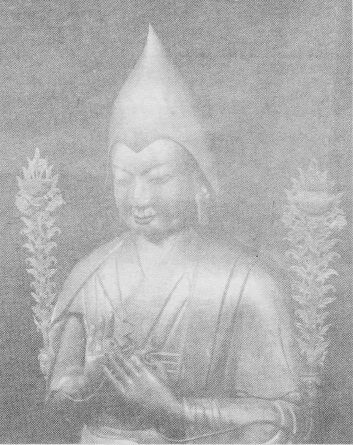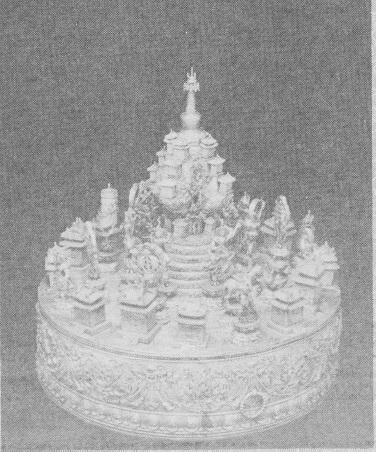| The following article is from the Summer, 1990 issue of the Snow Lion Newsletter and is for historical reference only. You can see this in context of the original newsletter here. |
Organized by lite Asian Art Museum of San Francisco and Tibet House New York, Wisdom and Compassion: The Sacred Art of Tibet is scheduled to travel to San F rancisco, New York and Houston in 1991-92. Counseled by an international committee of leading Tibetan and Western scholars and art historians, the exhibit will present an extraordinary collection of Tibetan art to a western audience for the first tune from a Tibetan perspective.
The exhibition will include 164 pieces, divided almost evenly between sculptures and paintings (thang-khas); the chronological range of the works extends from the 9th to the 19th century. The Hermitage Museum in Leningrad will be the exhibition's largest contributor, with over 30 works on loan. Some highlights of the Hermitage loan collection include a complete Medicine Buddha Mandala comprised of 50 individual sculptures and eight 12th-century paintings from the famous cache of Khara Khoto in Central Asia. The Statens Etnografiska Museet m Stockholm, Sweden zvill be supplying four altar sculptures, each over 6 feet tall, brought from Inner Mongolia by the explorer Sven Hedin. All of these works are being shown in this country for the first time.
Wisdom and Compassion will also feature masterpieces of Tibetan art from many museums and private collections in Europe and America, some of which have just come out of Tibet. Other museums and collections represented in the exhibition are: the Musee Guirnet, the British Museum, the Victoria and Albert Museum in London, the Museum of Fine Arts in Boston, the Newark Museum, the Jack Zimmerman Collection, the John Ford Collection, and the Los Angeles County Museum of Art.

Among the Buddhist arts of Asia, that of Tibet holds a unique and high position. It is an expression of a most profound and developed form of Buddhist thought portrayed in a styie which, though related to other great traditions of Buddhist art, rises to preeminence in its distinctly Tibetan qualities of clarity and spiritual realism and in its breadth of content and depth of meaning. Although it is characteristic of this an to incorporate some aspects of Indian, Central Asian and Chinese Buddhist art, Tibetan Buddhist an always creates and sustains a special aesthetic and religious vision which is apparent in the exhibition. Although this an has much to offer the world, it is as yet relatively little known or properly understood and appreciated.
The goal of Wisdom and Compassion: the Sacred An of Tibet is to present and explain the unique an of Tibet, and in doing so to offer a more comprehensive and accurate understanding of Tibetan culture, which still preserves precious spiritual qualities long lost to the modern West. Because this is primarily a religious an, the understanding of certain aspects of Buddhist thought, philosophy and practice is also of major consequence. Since all of these elements are grounded in the motivation and manifestation of compassion, this most noble of all human feelings and endeavors is a preeminent concern of the whole exhibit both as it affects individuals and, in the greater context, the entire world.
The exhibition will create a highly original space, an explicative matrix itself emerging from the art and culture of Tibet. As the inheritor of the humanistic and cultural treasures of India's Buddhist period (ca. 500 B.C. to 1100 A.D.), Tibet produced one of the world's most astonishingly sophisticated, profound and beautiful art traditions lasting more than 1,000 years. This art is described, analyzed and interpreted in terms of its iconography and religious meaning, its aesthetic qualities, its chronological developments and regional variations in style, in order to inform the public about the nature of this art and the culture that produced it. As such the an provides insights into the highest expression of Tibetan culture. Furthermore, Tibetan art, authentically presented as intelligible in its own context, will introduce to the west a new aesthetic vision of the unity of the spiritual and the realistic.
The Arrangement of the Exhibit
These themes of Tibetan an and culture, Buddhism, the spiritual-realistic aesthetic and the pervasive leitmotif of compassion will all be introduced in the exhibition through the profound symbolism of the sacred mandala, the mystic mansion and perfected cosmos of the Buddhas.
The exhibition will be organized around the governing principle of the mandala, a diagram of the cosmos. The actual viewing of the exhibit will be a journey for the viewers, in which they move step-by-step towards the highest levels of each theme. The exhibition will present the stages of progress within a mandala from the outer and more worldly spheres towards the trans-mundane, transcendental realm of the Pure Lands at the inner mystic core of the mandala reached in the final room of the exhibit. In addition, in the final room monks from Namgyal Monastery will be creating a mandala made of fine powdered sand.
The works will be grouped into a number of major sections based upon subject. In order for the general public to grasp the significance of the an as well as to follow the evolving of the mandala sequence, each section will be centered on a specific lojjic _oi iconography. In most cases, works will also be arranged by a secondary principle of chronological development so that the various stylistic changes between major periods will also be readily apparent. Each section will have its own distinct mood and impression so that the viewer will be conscious of the changes from room to room and be aware of the contrasts, which will lend a flavor of anticipation and interest to the process of viewing.
The following is a summary of the sections in order of viewing within the exhibit:
Part I: The Tibetan Buddhist Historical Universe
This part will consist of representations in six subsections of the figures who brought Buddhist teaching to the world, spread it widely, refined and perfected it. Beginning with the historical Buddha Shakyamuni, his life and past lives (Jatakas), the sequences will then present the Arhats (saint-disciples of the Buddha), the historical Bodhisattvas (those beings on the path to Buddhahood who embody the universal teachings of compassion and wisdom in Mahavana Buddhism), the Ornaments of India (the great Buddhist teachers and philosophers of India, such as Nagarjuna), the Mahasiddhas (great tantric adepts) and the Kings of Dharma, including the mythical kings of Shambhala, the historical kings of Tibet and the Heavenly kings who are protectors of the universe. These figures are shown in examples of painting and sculpture, many of monumental proportions and presented in a clear, orderly ways which reveal their special and often contrasting characters, but whose essence is the fulfillment of compassion through teaching, practicing and protecting.
Part II: The Main Monastic-Orders
Part II focuses on the four main Tibetan Buddhist orders, the Nyingma, Sakya, Kagyu, and Geluk, with their-.major masters, deities and practices. From this part with its four subsections> the viewer will become ( aware of the method of practice and the' masters of practice, both of which point to the realities of practice in the achievement ol compassionate action leading to the attainment of individual peace, world harmony and enlightenment. The particular character of each order and its method will be clearly revealed and will make some elements of Tibetan Buddhism and its special culture more vivid, interesting and accessible. Within this context the true nature of the wrathful and erotic practice deities will be explained as manifestations of compassion and wisdom on the level of the trans-mundane. Here the human teachers and mystical deities seem to be in a counterpoint of the highest subtleties of existence and the viewer can partake of this dialogue. This engagement of the viewer offers the chance for an uplifting encounter bcivvenuiit i, die uuuumsi ami the Western cultures and their respective ideals and thought. In this way it is hoped that the viewers will come to understand some of the basic ideas of Buddhism within the Tibetan interpretation and context.
Part III: The Transcendent Pure Land Realms
The final part has three subsectionsThe Cosmic Bodhisattvas, The Cosmic Buddhas, and The Pure Lands, including the Land of Snows (Tibet)that will lead the viewer into the transcendent cosmic realms and culminate with a large consecrated powder mandala. The mandala of Kalachakra, a seven-by-seven-foot two-dimensional formed of exquisite powdered minerals and stones depicting the mystical palace or universe of Buddha as Kalachakra, will be made in situ by Tibetan monk artists in the center of the final gallery. It will symbolically form the core and climax of the entire mandala-like construct that the viewer has moved through from the beginning of the exhibit.
This final part brings the viewer into touch with the highest elements in Buddhist symbolism and practice. The visual experience will be splendid, with some of Tibet's oldest paintings and greatest sculptures in these sections in addition to the spectacularly brilliant powdered mandala as the centerpiece. By this point, the viewer will be aware of and come to fully appreciate the wonderfully high level of cultural, artistic and religious achievement of the Tibetan people.
Conclusion
The figures seen in this apparently strange an are not in the least remote from this world. The experiences, concepts and lives portrayed are all applicable to the present day and should have a beneficial and stimulating impact on the minds and hearts of the viewers. Not only the content, but also the manner of portrayalthe exquisite detail, skillful line mid beauty of colorholds the attention and ' expresses an interpretation and expression that is a part of our world, but which may not have been seen or properly understood by many.


